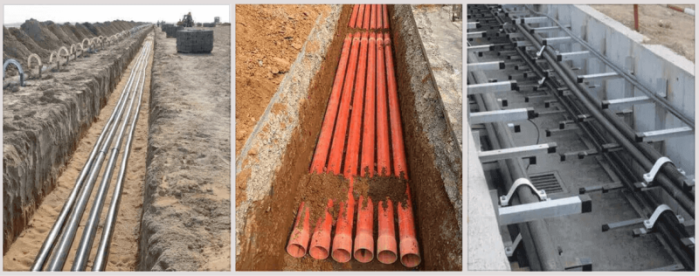How to choose the right cable sizes is crucial for ensuring safety, efficiency and compliance with industry standards. This article aims to guide you through the critical factors that influence cable size selection, providing the knowledge you need to make informed decisions.
1. Understanding Cable Sizing Basics:
The primary principle in choosing the right cable size is ensuring that the cable can handle the required current load without causing excessive voltage drop. This involves calculating the installed current rating (Ic) by multiplying the base current rating (Ib) with derating factors that account for installation conditions such as ambient temperature, grouping of cables, and soil thermal resistivity. The formula for this calculation is Ic=Ib x Kd, where Kd is the product of all derating factors.
2. Installation Method:
The method and location of cable installation play a significant role in determining the appropriate cable size. Enclosed installations, such as in conduits, may require larger cable sizes to manage heat dissipation effectively. Common installation methods include in conduit, on cable trays, in free air and direct burial.

3. Cable Material and Construction:
Cable insulation material affects the maximum operating temperature and thus the cable size. Common materials include PVC, XLPE and EPR, with maximum operating temperatures of 70°C, 90°C and 120°C, respectively. The choice between these materials can depend on factors such as cost, safety requirements and the specific application.
4. Cable Length and Ambient Temperature:
The length of the cable and the ambient temperature in which it will operate are crucial factors. Longer cables and higher ambient temperatures can lead to increased resistance and a consequent voltage drop, which may necessitate a larger cable size to maintain efficiency.

5. Number of Circuits:
When multiple circuits are placed together, the cable size may need to be increased to account for the combined heat generation and potential voltage drop across the system.
6. Voltage Ratings and Safety:
Understanding voltage ratings is essential when matching cable specifications to application requirements. Incorrectly sized cables can lead to safety hazards and operational inefficiencies. It’s crucial to select cables with appropriate voltage ratings to ensure safety and compliance with electrical regulations.
7. Interpreting Cable Size Charts:
Cable size charts provide a blueprint for selecting the right cable sizes based on parameters like conductor size, insulation type, and current-carrying capacity. Engineers must balance various factors and navigate tradeoffs while deciphering the chart’s information to ensure precise cable selection.
| Cross-Sectional Area (mm²) | Approx. Overall Diameter of Insulated Cable (mm) | Single Phase Current Rating (Amps) | Three Phase Current Rating (Amps) |
| 1.5 | 2.9 | 17.5 | 15.5 |
| 2.5 | 3.53 | 24 | 21 |
| 4.0 | 4.4 | 32 | 28 |
| 6.0 | 4.68 | 41 | 36 |
| 10 | 5.98 | 57 | 50 |
| 16 | 6.95 | 76 | 68 |
| 25 | 8.7 | 101 | 89 |
| 35 | 10.08 | 125 | 110 |
| 50 | 11.8 | 151 | 134 |
| 70 | 13.5 | 192 | 171 |
| 95 | 15.7 | 232 | 207 |
| 120 | 17.4 | 296 | 239 |
| 150 | 19.3 | 300 | 262 |
| 185 | 21.5 | 341 | 296 |
| 240 | 24.6 | 400 | 346 |
| 300 | 27.9 | 458 | 394 |
| 400 | 30.8 | 546 | 467 |
| 500 | 33.8 | 626 | 533 |
| 630 | 37.6 | 720 | 611 |
Choosing the right cable size is a critical task that requires a deep understanding of electrical principles, installation conditions, and safety standards. By considering the factors outlined in this article, I believe you can make informed decisions that ensure the safety, efficiency, and longevity of their electrical installations. Remember, the right cable size is not just about meeting the immediate needs but also about future-proofing your electrical systems for years to come.
Want to know more about XLPE insulated electric cable please click here.

Please contact us for a free quotation by the below form. We promise the quickest response within 8 hours.